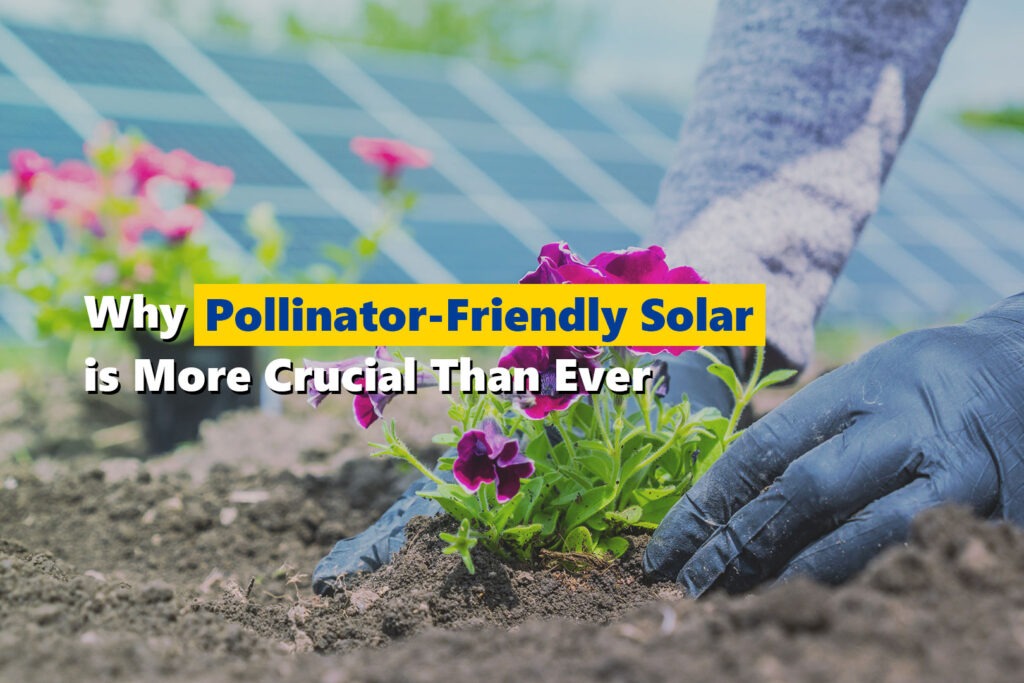
There’s been an increased buzz about the importance of pollinators over the years. Unfortunately, with large-scale solar farms, the solar industry has had a negative impact on pollinator habitats in the past. Those solar farms damaged the habitats of some of our most important pollinators — bees, butterflies, moths, hummingbirds, and bats. The good news is we’ve come a long way since then.
Today, pollinator-friendly solar farms have become a popular initiative, providing renewable power without harming the environment. Below, we’ll explain the basics of pollinator-friendly solar.
Why Pollinators Are Critical to Our Ecosystem
Different pollinators are attracted to different plants, and therefore pollinator habitats play an essential role in the ecosystem. For example, bees tend to be attracted to bright, daytime flowers, while bats are often attracted to pale, nocturnal flowers. In particular, bees fertilize most of our favorite flowers and pollinate a third of the plants we eat.
As bees and other pollinators visit different plant species, collecting nectar and pollen to feed themselves and their offspring, they provide services that are crucial to both plants and humans. Without butterflies, such as the iconic monarch butterfly, we could lose many of the brightly-colored wildflowers across the world. Without bumble bees, cranberries, blueberries, strawberries, plums, zucchinis, melons, sweet peppers, and tomatoes might not be sustainable through large-scale agricultural production anymore.
Pollinators are vital to the success of about 35% of global food crop production, and according to the U.S. Department of Agriculture, there are over 100 crops grown in the United States that depend on pollination. Bumble bees alone can pollinate up to 5,000 plants in a single day!
What is Pollinator-Friendly Solar?
There are two important components to making solar installations pollinator-friendly. The first component is to ensure that solar projects have a low-impact footprint on natural areas. This means prioritizing building solar projects and other types of renewable energy on low-impact sites, such as closed mines and landfills rather than in natural areas. This ensures that solar developers are not taking natural vegetation away from the pollinators in order to produce clean energy. There are other options for building a solar array than mowing down a vibrant meadow of wildflowers, after all.
The second component of building pollinator-friendly solar arrays is to make use of the unused land area around the ground-mounted solar panels and provide suitable habitat and native vegetation for local pollinators. For example, pollinator-friendly vegetation only grows to about knee height, so it can provide the same pollination benefits without impacting solar performance.
The Benefits and Environmental Impact of Pollinator-Friendly Solar Farms
A 2019 study published in Nature Sustainability found that co-locating agricultural interests with solar farms can help diversify the agricultural company’s revenue sources while also reducing land-use competition.
On the ecological side of things, pollinator-friendly solar farms in Minnesota are looking at whether pollinator-friendly solar installations can benefit both insect populations and local agricultural production. The variability in forage and nutrition can influence pollinator health. It’s possible to strategically select seed mixes that will invite a high biodiversity of pollinating organisms to the field, therefore benefiting the local natural ecosystem.
What Types of Plants & Flowers Attract Pollinators?
Pollinators have co-evolved with the plants that they pollinate over millions of years, leading to a fascinating array of pollination strategies and plant adaptations. While there are some very fascinating and unique plants out there that attract some specific pollinators, if you’re looking to create an oasis for a biodiverse set of pollinators, then there are a few rules of thumb to follow:
- Sustain nutrition throughout the year by planting a variety of flowers that bloom from early spring through fall.
- Group plant species together, rather than planting them individually, as this makes it easier for a pollinator to locate its preferred food source.
- Do not use chemical fertilizers, herbicides, or pesticides.
- Provide nearby water sources for the pollinators.
Deciding on the best pollinator-friendly plant species to place on a solar site often involves collaboration with local conservation organizations and environmental resource management agencies. For instance, the best native plants in states like Iowa and Illinois will differ from the best plants to use in states like California or Vermont.
Pollinator-Friendly Community Solar vs. Rooftop Solar
Pollinator-friendly solar arrays are best suited for ground-installed solar farms where soil is already available, rather than for rooftop solar installations. This, along with the hassles of rooftop solar, adds another reason why Community Solar shines so bright above the other options out there.









